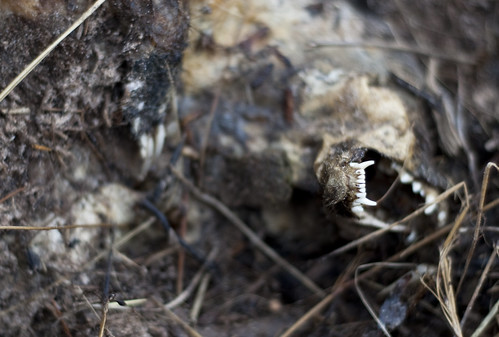It was a bloated, hairless, yellowed, waterlogged, maggoty skunk corpse. Its jaws were wide open, resembling some monster from a horror movie, not the furry, black-and-white mammal with which we are all so familiar. Maggots surged from its mouth and eye sockets. It was the first -- and only -- time that, during this project, I was ever disgusted by an animal corpse. It took me a few minutes to get used to the maggots, as they weren't something I expected to see on a late-November day. I then began to photograph the skunk -- and to this day, it has been the hardest thing for me to photograph in the Useless Creatures series.
To put it frankly, there was nothing appealing about the body. It wasn't recognizable as a skunk, there were maggots leaking from its orifices, and its mouth looked so horrifying, demonic, almost. And yet -- there was something extremely compelling about its teeth. They were so white and sharp.
 We rarely see animals in such a bizarre state of decay, and as a result, when we do see them like this, it's quite shocking. (Here is another angle of the corpse, view at your own risk.) To protect the body from snow and footsteps, Steph and I stacked a good deal of driftwood atop it. This would also serve as a marker so that we would be able to locate the body again.
We rarely see animals in such a bizarre state of decay, and as a result, when we do see them like this, it's quite shocking. (Here is another angle of the corpse, view at your own risk.) To protect the body from snow and footsteps, Steph and I stacked a good deal of driftwood atop it. This would also serve as a marker so that we would be able to locate the body again.Today, we returned to November Skunk. Amazingly enough, several months later, it still smells just as vivid as a living skunk. It has a lot of decomposing left to do; plastered to the body are a number of fly pupae. Despite there not being a dramatic change in its appearance, already the corpse is starting to look more peaceful. Its color is beginning to match with its surroundings, and it is beginning to return to the earth.
 We will check back again in a few months.
We will check back again in a few months.




No comments:
Post a Comment